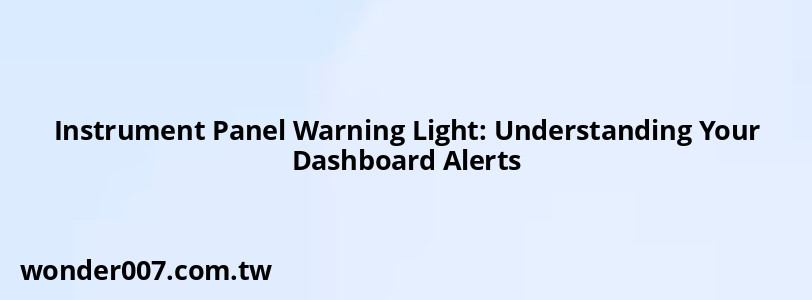Instrument Panel Warning Light: Understanding Your Dashboard Alerts

Instrument Panel Warning Light
The instrument panel warning lights are critical indicators on your vehicle's dashboard that inform you about the status of various systems. These lights can alert you to potential issues, ensuring your safety and the proper functioning of your vehicle. Understanding what each light means is essential for any driver.
When a warning light illuminates, it is crucial to address the issue promptly. Ignoring these alerts can lead to more severe problems or even accidents. Most drivers seek information on how to interpret these lights and what actions to take when they appear.
Common warning lights include:
- Check Engine Light: Indicates a problem with the engine or emissions system.
- Oil Pressure Light: Signals low oil pressure, which can lead to engine damage.
- Battery Warning Light: Suggests a charging issue with the battery or electrical system.
- Brake Warning Light: Indicates a problem with the braking system or low brake fluid.
- Tire Pressure Monitoring System (TPMS) Light: Alerts you to low tire pressure.
Each light serves a specific purpose, and understanding them can help you maintain your vehicle's health.
Types of Instrument Panel Warning Lights
Common Warning Lights
| Warning Light | Meaning |
|---|---|
| Check Engine | Engine or emissions issue |
| Oil Pressure | Low oil pressure detected |
| Battery | Charging system problem |
| Brake | Braking system issue |
| TPMS | Low tire pressure |
Less Common Warning Lights
While the above lights are frequently encountered, there are other less common warnings that drivers should be aware of:
- ABS Warning Light: Indicates an issue with the anti-lock braking system.
- Coolant Temperature Light: Signals that the engine is overheating.
- Transmission Fluid Temperature Light: Warns of overheating in the transmission.
Recognizing these warning lights can prevent further complications and ensure your vehicle operates smoothly.
FAQs About Instrument Panel Warning Lights
- What should I do if a warning light comes on?
Check your owner's manual for guidance. If it's critical, pull over safely and address the issue. - Can I drive with a warning light on?
It depends on the light. Some are urgent, while others may not require immediate action. - How can I reset a warning light?
A professional scan tool is often needed, but sometimes disconnecting the battery can reset minor alerts.
Understanding instrument panel warning lights is vital for every driver. By staying informed and proactive, you can ensure your vehicle remains safe and reliable on the road.
Related Posts
-
Ford Edge: Understanding Engine Coolant Over Temperature Issues
29-01-2025 • 306 views -
Mazda CX-7: Understanding Rear Main Seal Leaks
29-01-2025 • 159 views -
Honda P0325: Understanding Knock Sensor Malfunction
26-01-2025 • 161 views -
2006 Chevy Trailblazer Dash Warning Lights
31-01-2025 • 174 views -
Enable Chirp Feature on Your Car: A Step-by-Step Guide
27-01-2025 • 251 views
Latest Posts
-
2015 Chevy Traverse AC Recharge Port Location
01-02-2025 • 365 views -
Are O2 Sensors Covered Under Warranty
01-02-2025 • 338 views -
Power Steering Fluid Leak On Passenger Side
01-02-2025 • 419 views -
Rear Brake Caliper Piston Won't Compress
01-02-2025 • 312 views -
How To Turn Off Paddle Shifters Mercedes
01-02-2025 • 333 views
Popular Posts
-
EPC Light: Understanding Causes and Solutions
26-01-2025 • 1019 views -
EPC Warning Light: What It Means for Your Vehicle
27-01-2025 • 591 views -
V12 Engine Costs: What You Need to Know
26-01-2025 • 630 views -
Power Steering and ABS Light On: Causes and Solutions
27-01-2025 • 612 views -
Hino Warning Lights: Understanding Dashboard Alerts
26-01-2025 • 634 views
